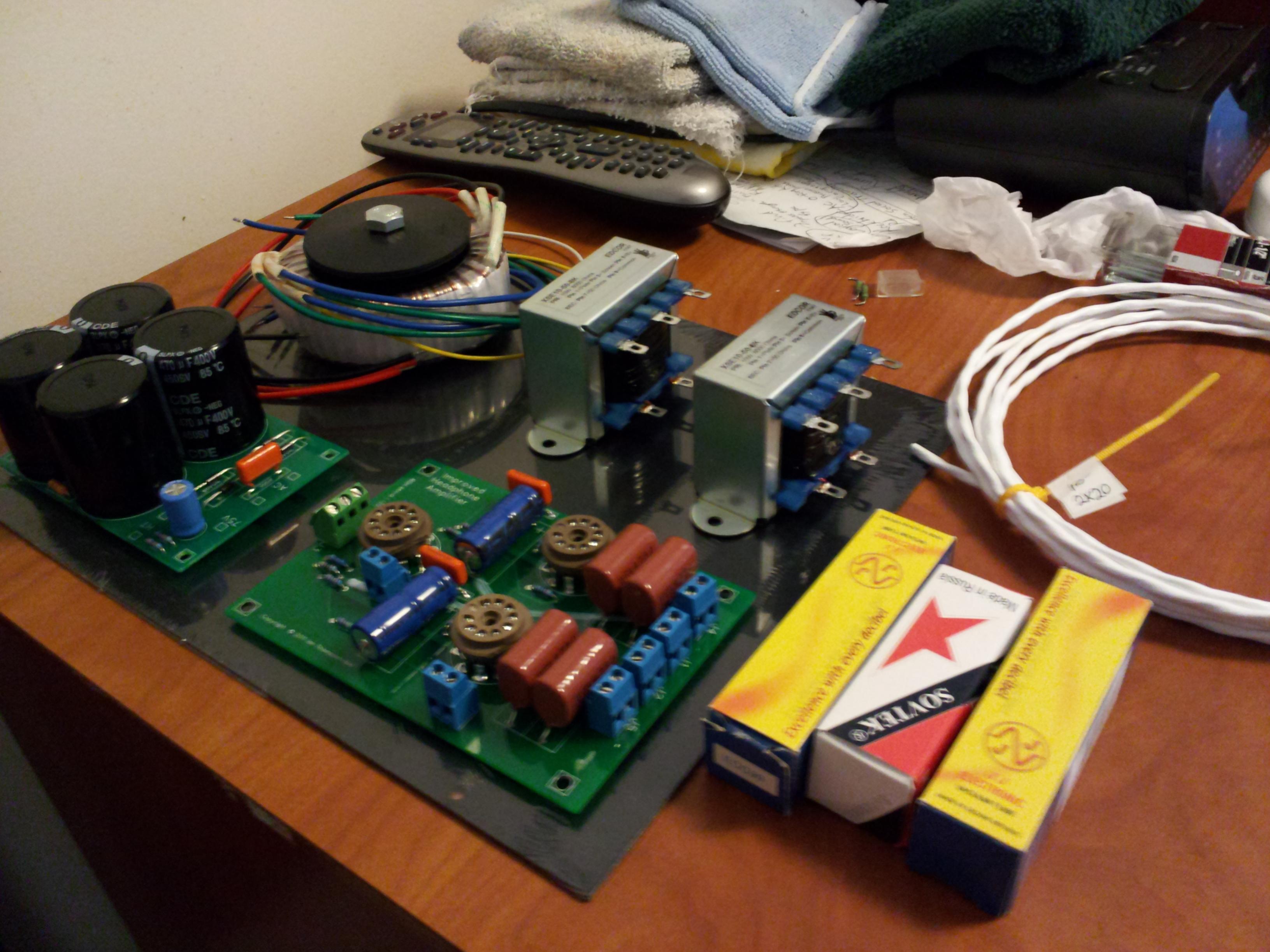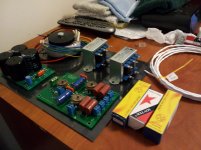I purchased an Antek an-05t240 toroidal mains transformer for my Improved tube headphone amplifier. I also just received most of the other major components of the amplifier so I'm fairly close to assembling the entire thing. I have a general understanding of how these components (output transformers, power supply, amp board, mains transformer) should be connected to each other, however I am unsure about how I should safely connect the mains transformer to the wall.
For testing, can I just hook the primary winding up to some lamp cord? Do I need a fuse? I would like to get the power connected to the tube heaters so that I have an idea if I am moving in the right direction with the project.
The final design will use a IEC receptacle with an integrated GMA fuse, but for now I would just like to see the amplifier power on.
I've also heard of people using light bulbs as a safety precaution, however I do not understand the point of this. I have also heard that a soft-on circuit should be used. Is this necessary for a headphone tube amplifier like this?
Here is a picture of all of the components that I am using:

Thanks to Ian Thompson-Bell for both the pcbs and all of the help that he has provided me.
For testing, can I just hook the primary winding up to some lamp cord? Do I need a fuse? I would like to get the power connected to the tube heaters so that I have an idea if I am moving in the right direction with the project.
The final design will use a IEC receptacle with an integrated GMA fuse, but for now I would just like to see the amplifier power on.
I've also heard of people using light bulbs as a safety precaution, however I do not understand the point of this. I have also heard that a soft-on circuit should be used. Is this necessary for a headphone tube amplifier like this?
Here is a picture of all of the components that I am using:
Thanks to Ian Thompson-Bell for both the pcbs and all of the help that he has provided me.
Attachments
A fuse is NEVER optional, at least not on the primary side of a transformer.
Get some screw terminals, they keep wires neatly untangled and add some safety to the wiring.
Read Power Supply Wiring Guidelines and Circuit Protection and Electrocution and maybe Elliott Sound Products - Linear Power Supply Design.
Get some screw terminals, they keep wires neatly untangled and add some safety to the wiring.
Read Power Supply Wiring Guidelines and Circuit Protection and Electrocution and maybe Elliott Sound Products - Linear Power Supply Design.
The point of using a lightbulb is that the resistance of the bulb depends on the temperature which depends on the current. A cold bulb has a resistance of a couple of tens of ohms (depending on the wattage of course), and will not affect the current flowing through the transformer, but if for some reason there's a short circuit on the primary or the secondary side, the current will rise and the bulb will light up, instantly limiting the current through the transformer.
Think of it as a poor man's current limiter.
Think of it as a poor man's current limiter.
Guys,
Thanks for the quick responses! Rodeo, those links were especially helpful. Embarrassingly, I've probably increased my knowledge of power supplies 50% just by reading those lol.
When I have the amp completed, should I install a soft-on power controller? Also, I was thinking about installing a mains rocker switch between the incoming line and the primary winding of the mains transformer. Then, in order to allow the user to switch off the amp from the front, I was thinking about installing a switch between the secondary windings and the power supply board. Does this make sense?
Thanks again
Thanks for the quick responses! Rodeo, those links were especially helpful. Embarrassingly, I've probably increased my knowledge of power supplies 50% just by reading those lol.
When I have the amp completed, should I install a soft-on power controller? Also, I was thinking about installing a mains rocker switch between the incoming line and the primary winding of the mains transformer. Then, in order to allow the user to switch off the amp from the front, I was thinking about installing a switch between the secondary windings and the power supply board. Does this make sense?
Thanks again
Last edited:
Someone who is really experienced may occasionally cheat and temporarily rig up a test arrangement involving mains. This is not a good idea and cannot be recommended. It should never be attempted by someone with less experience.
Best to start by building the mains end of the project and make it safe, then you can use it to test the rest as you build it. Better to be patient than dead!
Be careful to avoid switch confusion. Two switches means only one renders the equipment safe. Just use a double-pole switch on the mains. Soft-start is probably not necessary for low power items like a headphone amp.
Best to start by building the mains end of the project and make it safe, then you can use it to test the rest as you build it. Better to be patient than dead!
Be careful to avoid switch confusion. Two switches means only one renders the equipment safe. Just use a double-pole switch on the mains. Soft-start is probably not necessary for low power items like a headphone amp.
Use an IEC receptacle. Then you can unplug it from the amp and be 100% sure it ain't plugged in. You can sometimes salvage deluxe versions from obsolete equipment that have extras like filters, fuseholders, switches, 120/220 selector switch.
A slo-blow fuse on the secondary of the transformer is a good idea too; bridge rectifiers occasionally fail short (sometimes straight out of the package, although that one came from Radio Shack...). Soft start probably isn't necessary except with crazy big amps. It's easier to just use a generously oversized bridge rectifier.
A slo-blow fuse on the secondary of the transformer is a good idea too; bridge rectifiers occasionally fail short (sometimes straight out of the package, although that one came from Radio Shack...). Soft start probably isn't necessary except with crazy big amps. It's easier to just use a generously oversized bridge rectifier.
If there is catastrophic failure inside the transformer or in the rectifier immediately after the transformer, then the mains fuse in the Primary feed must rupture. !!!!!!
If you use the normal rule for motors and transformers of mains fuse rating = 3 times VA rating / mains voltage, then you end up with a fuse that may pass fault current for a long time until it eventually ruptures. Use close rated fusing to suit the transformer after start up and the worst case normal (not faulty) operating conditions.
Close rated fuse value = VA rating / mains voltage.
Most transformers will not start reliably with close rated fusing. They usually need a soft start. Using T rated fuses helps avoid these nuisance fuse failures.
eg.
200VA transformer on 230Vac supply.
Close rated mains fuse = 200/230 ~ T1A
Normal, no nuisance blowing, mains fuse = 3 * 200 /230 ~ 3A, or maybe 2.5A
Being safety conscious, I always close rate the mains fuse inside the equipment. I am more lax with the plug top fuse (BS1363/N09977) since it is preventing the mains cable setting fire to my house.
A far as I know BS1362 plug top fuses are available in 1A, 2A, 3A, 5A, 7A 10A and 13A values. Therefore I would use a 3A or 5A fuse and ensure the cable is rated >=6A
If you use the normal rule for motors and transformers of mains fuse rating = 3 times VA rating / mains voltage, then you end up with a fuse that may pass fault current for a long time until it eventually ruptures. Use close rated fusing to suit the transformer after start up and the worst case normal (not faulty) operating conditions.
Close rated fuse value = VA rating / mains voltage.
Most transformers will not start reliably with close rated fusing. They usually need a soft start. Using T rated fuses helps avoid these nuisance fuse failures.
eg.
200VA transformer on 230Vac supply.
Close rated mains fuse = 200/230 ~ T1A
Normal, no nuisance blowing, mains fuse = 3 * 200 /230 ~ 3A, or maybe 2.5A
Being safety conscious, I always close rate the mains fuse inside the equipment. I am more lax with the plug top fuse (BS1363/N09977) since it is preventing the mains cable setting fire to my house.
A far as I know BS1362 plug top fuses are available in 1A, 2A, 3A, 5A, 7A 10A and 13A values. Therefore I would use a 3A or 5A fuse and ensure the cable is rated >=6A
Last edited:
If there is catastrophic failure inside the transformer or in the rectifier immediately after the transformer, then the mains fuse in the Primary feed must rupture. !!!!!!
If you use the normal rule for motors and transformers of mains fuse rating = 3 times VA rating / mains voltage, then you end up with a fuse that may pass fault current for a long time until it eventually ruptures. Use close rated fusing to suit the transformer after start up and the worst case normal (not faulty) operating conditions.
Close rated fuse value = VA rating / mains voltage.
Most transformers will not start reliably with close rated fusing. They usually need a soft start. Using T rated fuses helps avoid these nuisance fuse failures.
eg.
200VA transformer on 230Vac supply.
Close rated mains fuse = 200/230 ~ T1A
Normal, no nuisance blowing, mains fuse = 3 * 200 /230 ~ 3A, or maybe 2.5A
Being safety conscious, I always close rate the mains fuse inside the equipment. I am more lax with the plug top fuse (BS1363/N09977) since it is preventing the mains cable setting fire to my house.
A far as I know BS1362 plug top fuses are available in 1A, 2A, 3A, 5A, 7A 10A and 13A values. Therefore I would use a 3A or 5A fuse and ensure the cable is rated >=6A
I disagree.
Normal calculations are for mains fuse to be 3 x VA rating of transformer. Use a Quick Blow.
IE if you have a 50VA transformer at 110V then use a fuse = 3x 50/110
That is a 1.5A Quick Blow
Do they understand BS1362 plugs in Texas?
As much as they understand migas in England.
post10 para 2 explains why I don't regard the 3times rule as being adequate and goes on to explain why close rating fusing is slightly safer.I disagree.
Normal calculations are for mains fuse to be 3 x VA rating of transformer. Use a Quick Blow.
Now let's hear your explanation for disagreeing.
.................I am more lax with the plug top fuse (BS1363/N09977) since it is preventing the mains cable setting fire to my house.
A far as I know BS1362 plug top fuses are available
almost certainly not, but having introduced plug top fuse, I gave a reference for those that wanted to follow it up.Do they understand BS1363 plugs in Texas? (fuses BS1362)
- Status
- This old topic is closed. If you want to reopen this topic, contact a moderator using the "Report Post" button.
- Home
- Amplifiers
- Power Supplies
- Mains Transformer Safety
